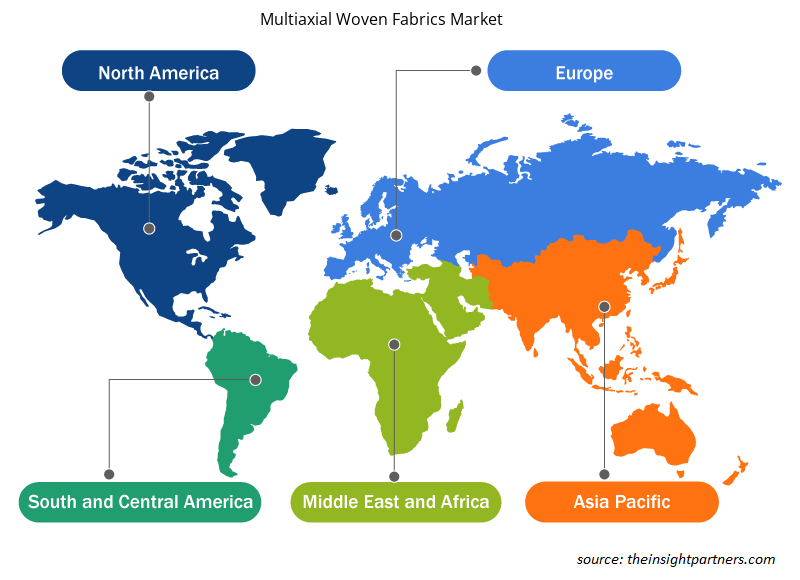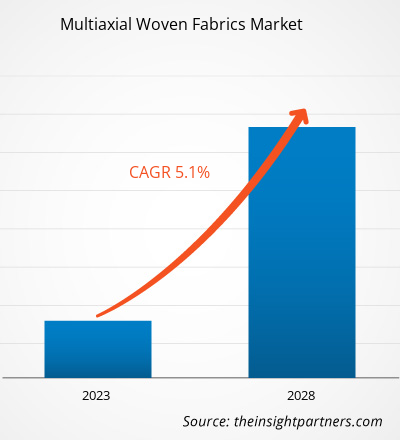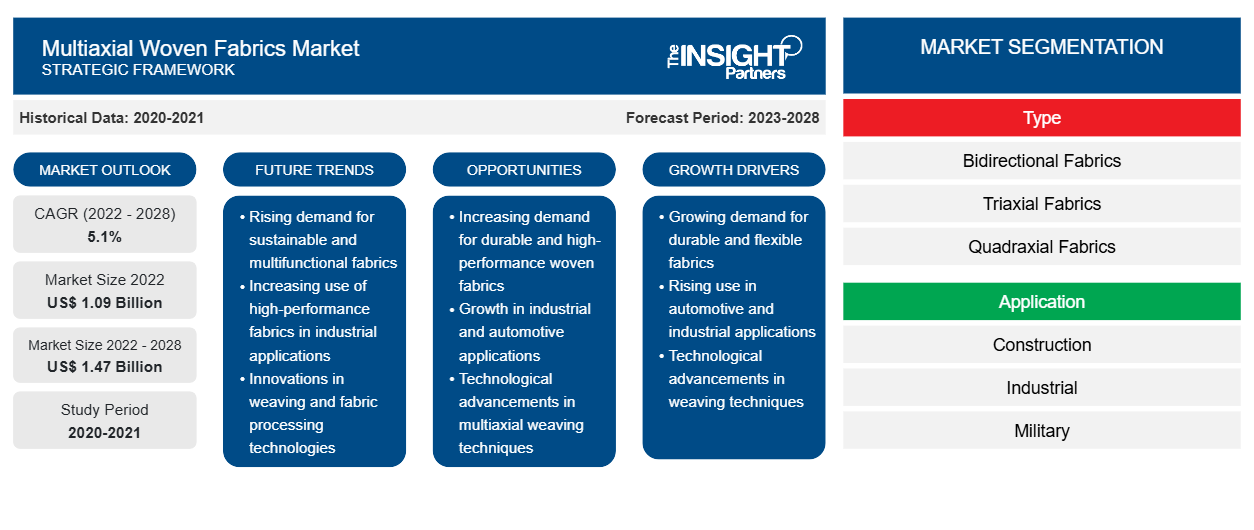[Rapporto di ricerca] Si prevede che il mercato dei tessuti multiassiali crescerà da 1.089,17 milioni di dollari nel 2022 a 1.469,01 milioni di dollari entro il 2028; si stima che registrerà un CAGR del 5,1% dal 2022 al 2028.
I tessuti multiassiali sono realizzati utilizzando diversi tipi di fibre, come fibra di vetro , fibra di carbonio, fibra aramidica e fibra naturale, e una combinazione di fibre. I tessuti bidirezionali, i tessuti triassiali e i tessuti quadriassiali sono alcuni tipi di tessuti multiassiali. I tessuti multiassiali sono applicati in diversi settori di utilizzo finale come edilizia, beni di consumo e militari.
L'Europa ha dominato la quota di mercato globale dei tessuti multiassiali nel 2022. In base al paese, il mercato europeo dei tessuti multiassiali è segmentato in Germania, Francia, Italia, Regno Unito, Russia e resto d'Europa. Il crescente utilizzo di materiali compositi in vari settori di utilizzo finale e la forte crescita dei settori automobilistico, marittimo, aerospaziale ed edile in Europa alimentano la crescita del mercato regionale dei tessuti multiassiali. Nel Regno Unito, l'energia eolica è una delle maggiori fonti di produzione di elettricità. Il governo del paese ha incluso l'energia eolica nel Piano in dieci punti per una rivoluzione industriale verde e nel Libro bianco sull'energia. L'industria dell'energia eolica sta svolgendo un ruolo importante nella transizione energetica della Germania. Secondo Germany Trade & Invest, la Germania è il principale mercato europeo dell'energia eolica, con oltre 63 GW di capacità totale. Il crescente settore dell'energia eolica in Europa guida la domanda di tessuti multiassiali.
Personalizza questo report in base alle tue esigenze
Riceverai la personalizzazione gratuita di qualsiasi report, comprese parti di questo report, o analisi a livello nazionale, pacchetto dati Excel, oltre a usufruire di grandi offerte e sconti per start-up e università
-
Scopri le principali tendenze di mercato in questo rapporto.Questo campione GRATUITO includerà analisi di dati che spaziano dalle tendenze di mercato alle stime e alle previsioni.
Impatto della pandemia di COVID-19 sul mercato dei tessuti multiassiali
Prima della pandemia di COVID-19, il mercato dei tessuti multiassiali era guidato principalmente da settori quali automotive, edilizia e costruzioni, aerospaziale e difesa, energia eolica e nautica. Nel 2020, vari settori hanno dovuto rallentare le proprie attività a causa delle interruzioni nelle catene di fornitura causate dalla chiusura dei confini nazionali e internazionali. La pandemia ha ostacolato i processi di produzione a causa delle restrizioni imposte dalle autorità governative in vari paesi. I tessuti multiassiali hanno importanti applicazioni nei settori aerospaziale e della difesa e automobilistico, dove vengono utilizzati per gestire il peso corporeo dei veicoli e la gestione del carburante. Sono anche ampiamente utilizzati nel settore delle costruzioni. Quindi, con la riduzione dell'attività in questi settori, anche la domanda di tessuti multiassiali è diminuita. La pandemia ha anche causato fluttuazioni nei prezzi delle materie prime. Tutti questi fattori hanno portato a una diminuzione della domanda di tessuti multiassiali. Tuttavia, nel 2021, le economie hanno iniziato a riprendersi poiché vari settori hanno ripreso le attività commerciali. Di conseguenza, diversi settori, tra cui aerospaziale e difesa, automobilistico ed edilizia e costruzioni, hanno mostrato segni di ripresa nelle loro attività. Anche vari settori stanno superando le conseguenze delle interruzioni nelle loro catene di fornitura di materie prime. Con una ripresa così promettente, si prevede che il settore industriale globale fornirà l'impulso per la crescita del mercato dei tessuti multiassiali nei prossimi anni.
Approfondimenti di mercato
La forte crescita del settore dei compositi guida la crescita del mercato dei tessuti multiassiali
I tessuti multiassiali vengono utilizzati per il rinforzo di materiali compositi. La crescente domanda di materiali ad alte prestazioni con proprietà quali elevato rapporto resistenza/peso, buona resistenza alla trazione, conduttività elettrica e altre determina la crescita del settore dei compositi. Inoltre, vi è una crescente domanda di compositi da parte di vari settori di utilizzo finale quali automotive, articoli sportivi, nautica, edilizia ed energia eolica. Nel settore automobilistico, i produttori preferiscono materiali leggeri per la fabbricazione di automobili garantendo al contempo sicurezza e prestazioni. I materiali leggeri hanno un potenziale eccellente per aumentare l'efficienza del carburante. I compositi possono ridurre il peso dei componenti automobilistici, il che ne aumenta l'utilizzo nel settore automobilistico. Vi è inoltre un'elevata domanda di compositi da utilizzare come materiali da costruzione in attrezzature sportive ad alte prestazioni grazie alla loro leggerezza, elevata resistenza, libertà di progettazione e caratteristiche di facile lavorazione e formatura. I compositi sono utilizzati in attrezzature sportive quali sci, mazze da baseball, mazze da golf, racchette da tennis e telai di biciclette. I compositi sono ampiamente utilizzati nel settore nautico in quanto sono durevoli e leggeri. I compositi pesano meno dei tradizionali materiali da costruzione nautici, il che li rende adatti all'uso nella costruzione di imbarcazioni. Inoltre, i compositi sono utilizzati come materiali di rinforzo in diverse applicazioni di energia eolica. Il crescente utilizzo di compositi in diversi settori di utilizzo finale alimenta la crescita dell'industria dei compositi. Quindi, la forte crescita dell'industria dei compositi sta rafforzando la crescita del mercato dei tessuti multiassiali.
Tipo Informazioni
In base al tipo, il mercato globale dei tessuti multiassiali è suddiviso in tessuti bidirezionali, tessuti triassiali, tessuti quadriassiali e altri. Il segmento dei tessuti quadriassiali ha detenuto la quota di mercato maggiore nel 2022. Un tessuto quadriassiale è costituito da quattro strati di orientamento del roving in fibra a 0°, +45°, 90° e -45°. Questo tessuto fornisce resistenza in tutte le direzioni. Sono ampiamente utilizzati per laminazione manuale, iniezione o infusione e stampaggio a trasferimento di resina. Questo tessuto può essere prodotto con la massima densità aerea rispetto a qualsiasi altro stile di tessuto.
3D Weaving SaRL, Sigmatex (UK) Ltd, Textum OPCO LLC, Cristex Composite Materials Ltd, Biteam AB, Albany International Corp, Tantra Composite Technologies Pvt Ltd, Parabeam BV, Halarit Composites GmbH e SGL Carbon SE sono alcuni dei player che operano nel mercato globale dei tessuti multiassiali. I player del mercato si stanno concentrando sulla fornitura di prodotti di alta qualità per soddisfare la domanda dei clienti. Stanno inoltre adottando strategie quali investimenti in ricerca e sviluppo, lanci di nuovi prodotti, collaborazioni e fusioni e acquisizioni.
Approfondimenti regionali sul mercato dei tessuti multiassiali
Le tendenze regionali e i fattori che influenzano il mercato dei tessuti multiassiali durante il periodo di previsione sono stati ampiamente spiegati dagli analisti di Insight Partners. Questa sezione discute anche i segmenti e la geografia del mercato dei tessuti multiassiali in Nord America, Europa, Asia Pacifico, Medio Oriente e Africa e America meridionale e centrale.

- Ottieni i dati specifici regionali per il mercato dei tessuti multiassiali
Ambito del rapporto di mercato sui tessuti multiassiali
| Attributo del report | Dettagli |
|---|---|
| Dimensioni del mercato nel 2022 | 1,09 miliardi di dollari USA |
| Dimensioni del mercato entro il 2028 | 1,47 miliardi di dollari USA |
| CAGR globale (2022 - 2028) | 5,1% |
| Dati storici | 2020-2021 |
| Periodo di previsione | 2023-2028 |
| Segmenti coperti |
Per tipo
|
| Regioni e Paesi coperti |
America del Nord
|
| Leader di mercato e profili aziendali chiave |
|
Attori del mercato dei tessuti multiassiali Densità: comprendere il suo impatto sulle dinamiche aziendali
Il mercato dei tessuti multiassiali sta crescendo rapidamente, spinto dalla crescente domanda degli utenti finali dovuta a fattori quali l'evoluzione delle preferenze dei consumatori, i progressi tecnologici e una maggiore consapevolezza dei vantaggi del prodotto. Con l'aumento della domanda, le aziende stanno ampliando le loro offerte, innovando per soddisfare le esigenze dei consumatori e capitalizzando sulle tendenze emergenti, il che alimenta ulteriormente la crescita del mercato.
La densità degli operatori di mercato si riferisce alla distribuzione di aziende o società che operano in un particolare mercato o settore. Indica quanti concorrenti (operatori di mercato) sono presenti in un dato spazio di mercato in relazione alle sue dimensioni o al valore di mercato totale.
Le principali aziende che operano nel mercato dei tessuti multiassiali sono:
- Tessitura 3D SaRL
- Sigmatex (Regno Unito) Ltd
- Testo OPCO LLC
- Cristex Materiali Compositi Ltd
- Biteam AB
Disclaimer : le aziende elencate sopra non sono classificate secondo un ordine particolare.

- Ottieni una panoramica dei principali attori del mercato dei tessuti multiassiali
Segnala i riflettori
- Tendenze industriali progressive nel mercato dei tessuti multiassiali per aiutare gli operatori a sviluppare strategie efficaci a lungo termine
- Strategie di crescita aziendale adottate dai mercati sviluppati e in via di sviluppo
- Analisi quantitativa del mercato dei tessuti multiassiali dal 2020 al 2028
- Stima della domanda globale di tessuti multiassiali
- Analisi delle cinque forze di Porter per illustrare l'efficacia degli acquirenti e dei fornitori che operano nel settore
- Sviluppi recenti per comprendere lo scenario competitivo del mercato
- Tendenze e prospettive di mercato, nonché fattori che guidano e frenano la crescita del mercato dei tessuti multiassiali
- Assistenza nel processo decisionale evidenziando le strategie di mercato che sostengono l'interesse commerciale, portando alla crescita del mercato
- Le dimensioni del mercato dei tessuti multiassiali in vari nodi
- Panoramica dettagliata e segmentazione del mercato, nonché dinamiche del settore dei tessuti multiassiali
- Dimensioni del mercato dei tessuti multiassiali in diverse regioni con promettenti opportunità di crescita
- Analisi storica (2 anni), anno base, previsione (7 anni) con CAGR
- Analisi PEST e SWOT
- Valore/volume delle dimensioni del mercato - Globale, Regionale, Nazionale
- Industria e panorama competitivo
- Set di dati Excel
Report recenti
Testimonianze
Motivo dell'acquisto
- Processo decisionale informato
- Comprensione delle dinamiche di mercato
- Analisi competitiva
- Analisi dei clienti
- Previsioni di mercato
- Mitigazione del rischio
- Pianificazione strategica
- Giustificazione degli investimenti
- Identificazione dei mercati emergenti
- Miglioramento delle strategie di marketing
- Aumento dell'efficienza operativa
- Allineamento alle tendenze normative























 Ottieni un campione gratuito per - Mercato dei tessuti multiassiali
Ottieni un campione gratuito per - Mercato dei tessuti multiassiali